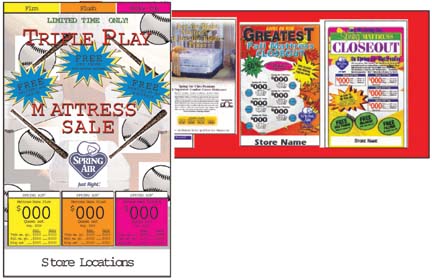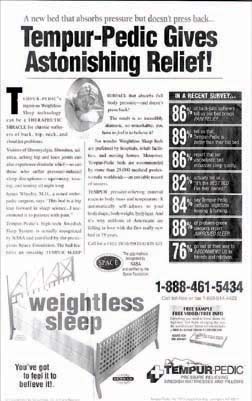Use advertising messages that win the trust of prospects.

Look Familiar? Selections From The Awful World of Mattress Advertising: Spring Air is a great company and produces great products, but they drop the ball (as do competitive mattress companies) when it comes to supplying advertising materials to retail stores. Like Sealy, Simmons and Serta, Spring Air supplies look-alike ads, virtually devoid of fashion, romance, and health appeals... ads that attempt to sell a “sack of sand” on price, without benefits and features. Furniture store managers who want to develop an effective bedding advertising program cannot rely on factory mats to sell for their store alone. Factory mats are designed hastily, after the national programs are completed, with one objective in mind: Display the brand name for every dealer in the city. (These ads don’t SELL anything). You are not getting CO-OP dollars when you run such ads, you are giving them. Compare with the SELLING ad by Tempur-Pedic below.
Nearly every week furniture store CEOs call to discuss the fact that their advertising no longer works. When asked what they think may be wrong, the answers are surprisingly similar. They explain that, “People don’t seem to believe advertising anymore.” Sometimes they add a comment such as: “It’s this Enron thing. People don’t trust businesses like they used to.”
There is truth in this perception. Just when America needed business leaders to step up and inspire the confidence of the people, the exact opposite happened. There is a crisis of integrity in our country. This does not necessarily mean people will not trust your advertising messages. It simply means that you are going to have to work harder to develop messages that win their trust.
People are still buying lots of furniture, mattress sets, and accessories. Not as much as in the “good old days,” but there is still a considerable amount of discretionary income in this economy and home furnishings are not perceived as frivolous commodities.
Last year, a very bright advertising manager employed by a major chain cut short a store-moving campaign in one of his small city locations. He explained that this action saved his company a lot of money due to his belief that the first three weeks of the sale had “taken all of the business out of the market.” “You can’t do three weeks of record sales and expect yet another record week,” he said. The reality was that he probably lost in excess of $100,000 in profitable sales by cutting off the last week of the promotion.”
To prove that his event had just scratched the surface of potential furniture and mattress business in that smaller market, we went to the internet. We found retail sales numbers available from the year before, proofing that this successful company was only getting a fraction of the market share it deserved. These facts persuaded him to go the full way with the promotion in a city with similar demographics this year. In the face of very tough market conditions (as we all know) this year’s effort (one week longer) achieved $73, 000 more in volume. The point of this story is that consumers are still investing their earnings and savings in home furnishings. Your job is to increase market share by telling your unique story. If you have any doubt about the percentage of market share you control, take the time to do a bit of research. You may be surprised.
ALWAYS TELL YOUR STORY
While it’s true that people don’t usually like to read ads or listen to commercials, they do love stories. Here is a success story that is hard to believe. A decorator store in the suburbs of Chicago needed help last December. In this market, newspaper and radio costs are high, and for a smaller operation such as this, television is out of the question. What made this store different from many others is that there was a great story to tell. It had unique merchandise and did most of the personal, creative things that a small store can do to give customers a fun shopping experience. The high-end, non price-driven nature of this store, precluded using promotion after promotion to stimulate business. The largest asset the store had was its story, which was not getting told.
To try to correct this problem, a deal was made with a local paper, to run a two-column by eight inch ad each week, using one color. Ads were used creatively and consistently to tell this store’s unique story, a little bit at a time. When this idea was first suggested, the storeowner said: “I don’t have that much to say. I can’t keep saying the same thing over and over again.” However, this same storeowner was known for “spellbinding” customers who came into his location for hours with talk of furnishings for the home. He also provided many unique services that would attract prospects, if they knew about them. He finally agreed to try this idea out for a year. After running these ads weekly for almost a year (with only two short-term sales events) the store is, believe it or not, 50% ahead of last year. And volume is building.
Please note that this is an achievement in merchandising and branding, not in advertising. The store itself is an achievement. If you have such a store, that is, a store with great merchandise offers, excellent prices, motivated sales consultants, and impeccable service, and yet you can’t seem to get your story across, the balance of this article will help you. Otherwise, if you are mediocre and looking for a quick fix, telling your story will not help much.

How To Take Market Share From Retailers Who Run Lazy Mattress Ads: Ad people know it is usually very hard to penetrate a commodity universe and establish market share. However, when those dominating the market are all using boring, inane appeals, it becomes easier. At left, Tempur-Pedic shows how to sell a sleep system with a print advertisement. In a national USA TODAY ad, 5 columns by 14 inches without color, they appeal powerfully to health concerns, clearly show how a Tempur-Pedic bed can solve them, give overwhelming evidence to support their claims, demonstrate a guarantee, and make a very strong action appeal. Of course nobody is perfect: the ad lacks a statement of value for the money. Also, the small line above the headline is called inversion, and will get almost no readership. Even so, it is miles ahead of competition, and takes a remarkable share of market from the lazy giants.
MAKING YOUR STORY BELIEVABLE
The dynamics of making a persuasive selling argument are simple, we all know one version or another of the formula. My favorite is the following five step sequence.
•Capture the interest of the prospect with a brilliant opening (or headline) that brings their attention to a need they have.
•Show that what you are offering will fill this need.
•Show that the cost of what you have is less than the VALUE you are offering.
•And this is the key step to establish credibility: Provide PROOF that what you have said is true. This proof is achieved by telling your story... and being believed.
•Give your customers a compelling reason to buy now.
Let’s focus on the fourth statement which is to provide PROOF that what you have said is true. This proof is achieved by telling your story... and being believed. If you are a consistent FURNITURE WORLD reader, you may recall the formula for a winning advertisement is the same as the formula for telling a great news story: Who? – what? – when? – where? – how? and why? (New subscribers can find past articles in the editorial archives on www.furninfo.com in the “marketing management index.”) A degree of credibility must be achieved in each of these categories, but the most acute need for credibility is the WHO? factor. When customers see your ad or talk to a salesperson, they are thinking: “Can I trust this person?” In furniture retailing this question is more important than for most other commodities.
Why is credibility so important in a furniture or mattress purchase? Because the customer is afraid that she may be buying a “sack of sand”. Furniture is generally purchased infrequently. She does not know many furniture brands, nor does she know how to, by herself, choose the sofa or a dining room set that best meets her needs. This situation forces most furniture buyers to look for a store and/or a salesperson they can trust. While it is true that large mattress companies achieve brand recognition through national advertising, they often do such a miserable job of telling their story that off-brands, private labels and the so-called mattress “factories” get a huge amount of market share. This is true even though most of these outlets run ads that are weak and look-alike.
When almost everyone is running weak, look-alike ads and almost no one is telling their own unique benefit story, everything becomes table stakes. In other words, everyone is making free “No – No – No” offers, “free removal of old bedding,” “free bed frame,” and on and on. There is nothing to distinguish the offers. Mattress ads compound this sorry state with meaningless lists of prices accompanied by only meager scraps of information to indicate why one price should be higher than another. It would have been impossible for mattress specialty stores to take market share had the majority of full-line furniture stores adequately told their stories.
How then, do you nail down your selling story and buttress your credibility?
STATEMENTS SUPPORTED BY SPECIFIC POINTS
Show a photo of your store whenever it is practical. Make sure it is a good shot, and have the newspaper retouch it for you. Remember, however, who you are is far more than a building with a name on it. When, a prospective customer glances over your ad, he or she should learn several things about you without much effort. Moreover, what you are should be so woven through the ad that it would be impossible for another merchant to put his sig on it and make it work. How long have you been in business? Think of new ways of communicating this in every ad. What is your guarantee? Is it simple? Don’t offer a price guarantee and then add a bunch of stipulations. As a matter of fact, a price guarantee is table stakes these days. What people want is a sincere promise of satisfaction. In price, in quality, in service, in every way.
I know a retail store owner who could deliver his merchandise the next day, however, he never told anyone this fact. Business increased when he got the story out. Another had free delivery, but left this out of his ads at least half the time. You must distinguish your services. For example, delivery, whether free or not, can be embellished. In the old days everyone offered free delivery. But Curtis Brothers Furniture in Washington D.C. was one creative company. In the sixties they were the largest home furnishings store under one roof in America. They achieved a million dollar day (in today’s dollars) back in 1965. They did not just offer customers “free delivery.” Curtis Brothers offered “free white glove, red-carpet delivery.” The drivers actually rolled out a red carpet on the customer’s steps, and they wore spotless white gloves and white coveralls. They were professionals, and they looked like it. But, heck, who can take the time or trouble to police corny ideas like that these days? Not many stores, it is true. Only great stores do things such as this. Curtis was the only store I know of that did it even back then, when we only thought retailing was tough.
Do you offer a big selection? How big? If it’s a million dollars worth, tell the customer about it now and then. Price item ads are far more effective if you promise me there are many equally exciting values on display. If you have fifty-seven recliners in stock, tell me about it. If you have a couple dozen complete room groups with designer-selected accessories, and your competitor has three, don’t do him a favor by not telling me. If your sales consultants have been factory-trained to represent the benefits of a specific sleep system, tell the story. Describe the things that will make my shopping experience special and fulfilling. If I visit your store, make sure I leave with a little brochure that reminds me of all the value-added features of doing business with you. This “silent salesperson” will remind me of you, and I’ll be back.
DON’T FORGET THE RELATIONSHIP FACTOR
Never forget, although an illustration of your store is important, people cannot have relationships with a cold, brick building. They cannot have a relationship with a brand, no matter how great it is. People want a face, a personality to deal with. The sales consultant they happen to deal with becomes your store. Be sure your sales consultants are sold on telling the unique factors that make you special. When your delivery team appears at the customer’s door, they represent your store. Give them the time and attention they need to understand the importance of being probably the last representative of your store in the chain of the shopping experience. As one delivery team captain explained: “We have to resell the customer on their purchase by assuring them they made a great choice and got a wonderful value.”
Once in a while show a photo of your store manager and include a personal message. This technique, has proven to be very successful, and most managers enjoy the exposure. The faceless corporation is a mysterious non-entity, but people can relate to a photograph of a manager and a message from her. Don’t underestimate the power of this idea. During the Christmas season some store owners run very effective stock-reduction events, and feature their wives and children in a Christmas setting. Hokey? Maybe, but it works quite well because people feel appreciative when the owner of a store takes the trouble to figuratively look them in the eye and talk straight with them. Research indicates people actually feel honored when the owner of the store waits on them. Bottom line, retailing today is about relationships, just as it has always been. Ideas about branding and core competencies and all such things are helpful and important, of course. But don’t neglect the biggest edge of all, the People Medium. It’s your most powerful tool.
Sell your managers on your unique factors. Sell your sales consultants and office people on ways to communicate the things that make your store different. Sell your warehouse people and delivery teams on their important role in achieving your mission. Make your associates believers by convincing them you are a believer, and they will make your customers believers. Never get tired of telling your story and living your values, and your team will keep them fresh and alive for you.

Ads That Sell For Your Store Alone Inform Who? What? When? Think you have troubles? How would you like to do business in the suburbs of Detroit with sky-high media costs and a limited market focus? Namely: imported dining room tables and chairs? The promotional ad at left pays for itself because it is loaded with benefits and products, and has all the elements needed for a selling proposition. The WHO? factor is clearly emphasized. A box gives “nine reasons why” and informs the customer that Watch Hill Interiors is “Detroit’s largest importer of Dining Tables and Chairs.” (In case the reader misses this distinguishing fact, it is repeated in large type near the sig). When supplemented by a regular non-price appeal program, such efforts are very difficult to overtake, and prospects will be diverted from full-line furniture stores.
Larry Mullins, President of UltraSales, Inc., has 30+ years experience in the front lines of retail furniture marketing. Larry's mainstream executive experience, his creative work for "promoter-specialists," and study of advertising principles has enabled him to continually develop new High-Impact strategies for independent furniture retailers that are sound, complete, and innovative. Inquiries can be sent to Larry care of FURNITURE WORLD at editor@furninfo.com.